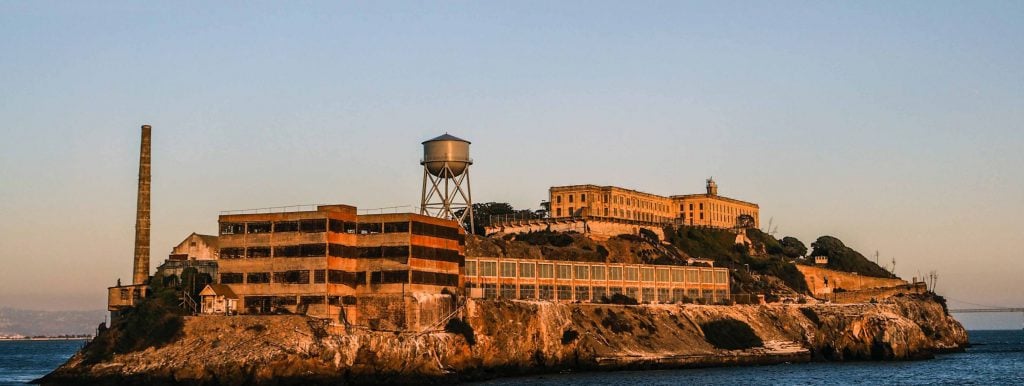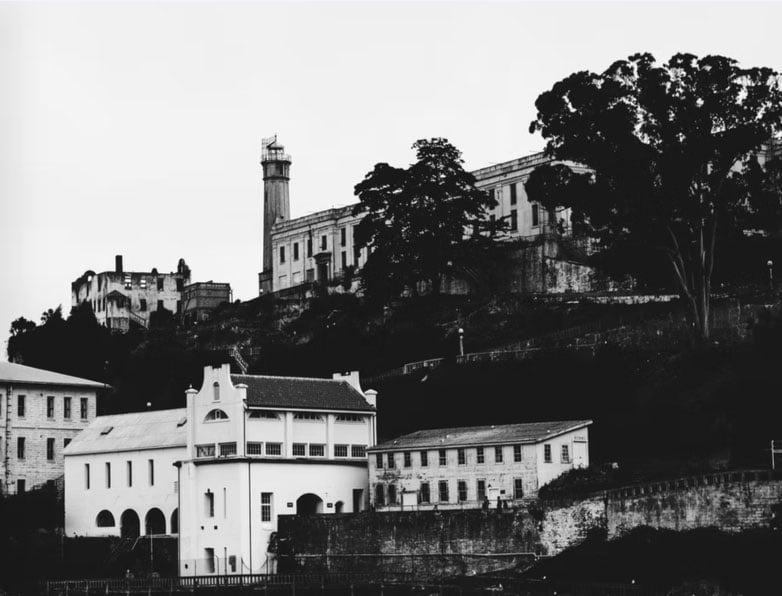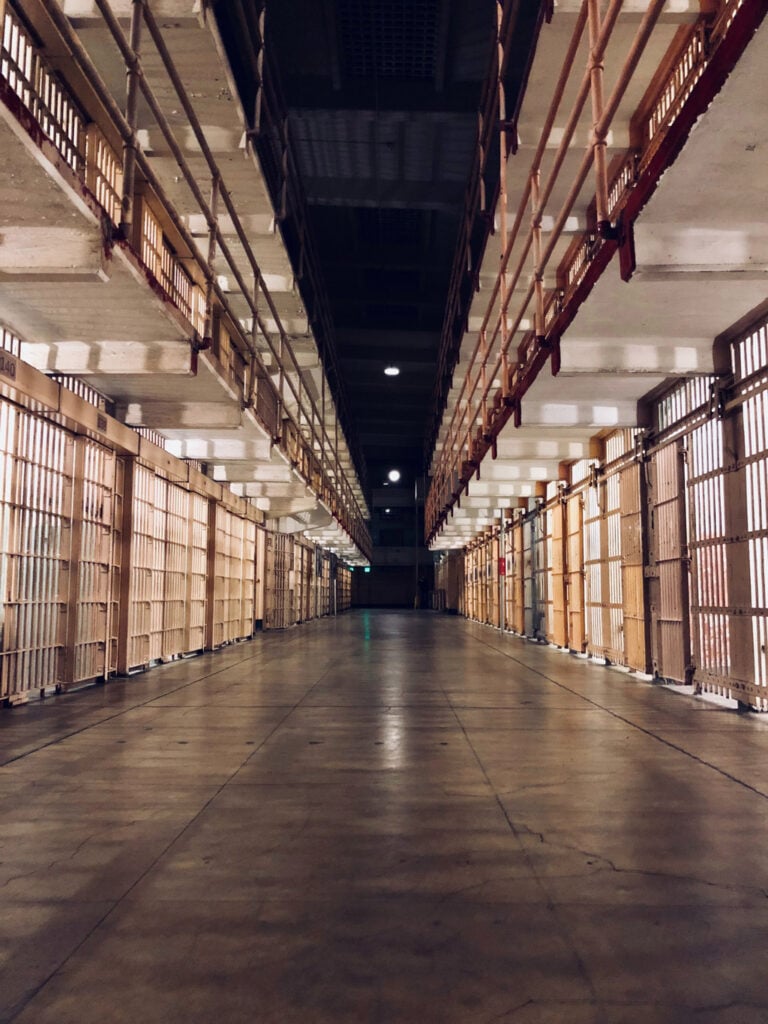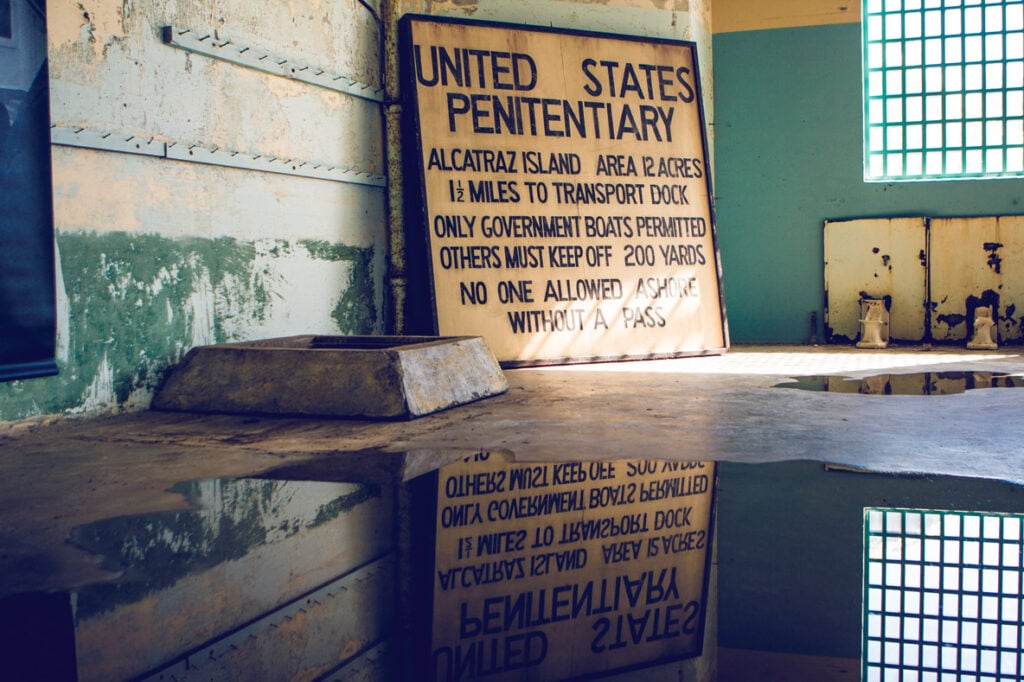Nổi bật trong bài đăng này
Tiếp tục khám phá
San Francisco, California
San Francisco thiết yếu
Tìm hiểu thêm
Bởi Blogger khách: Michael Esslinger
Năm chữ này dường như được viết bằng lửa trên tường phòng giam của tôi : "Không có gì có thể đáng giá này."
Khi Nhà tù Liên bang Hoa Kỳ mở cửa trên đảo Alcatraz vào tháng Tám năm 1934, nó đã trở thành biểu tượng của cuộc chiến chống tội phạm có tổ chức của Mỹ. Alcatraz được thiết kế để bắt các vị vua tội phạm của Mỹ, tước bỏ danh tiếng và tai tiếng công khai của họ, sau đó nhốt họ vào trạng thái ẩn dật dữ dội đến mức họ sẽ bị lãng quên trong nhiều thập kỷ.
Vào cuối những năm 1930, Bộ trưởng Tư pháp Homer S. Cummings nhận xét, trong một cuộc phỏng vấn với Tạp chí Collier, rằng George "Machine Gun" Kelly và các cộng sự của ông đã giúp định hình khái niệm Alcatraz thành hiện thực.
Những người như Machine Gun Kelly và Al Capone thường thống trị các tiêu đề của các tờ báo nổi tiếng nhất nước Mỹ. Alcatraz là để phục vụ như là giải pháp của chính phủ để ngăn chặn tội phạm có tổ chức và bịt miệng các Sa hoàng mỉm cười với máy ảnh bất chấp pháp luật.
Cuộc phỏng vấn của Collier đã tập trung vào tình thế tiến thoái lưỡng nan của chính phủ rằng chúng tôi cần một nơi nào đó mà "sản phẩm cuối cùng" của hệ thống thực thi pháp luật của chúng tôi có thể bị giam giữ. Chúng tôi cần một nơi cho những "nghệ sĩ trốn thoát" khéo léo và cho những người khó chữa, phá vỡ kỷ luật hoặc tìm cách duy trì liên lạc với thế giới ngầm. Đến mùa hè năm 1933, luật bắt cóc đã được ban hành một năm trước đó đã đưa ra tòa án liên bang một loại tội phạm đặc biệt nguy hiểm. Nếu bị kết tội, anh ta sẽ phải thụ án chung thân.
Trường hợp của George "Machine Gun" Kelly
Đây là trường hợp của George Kelly hay "Machine Gun" Kelly vì anh ta được biết đến nhiều nhất trong hầu hết các hộ gia đình. Trên Alcatraz, anh ấy chỉ được biết đến với cái tên Tù nhân # 117. Alcatraz được hình thành để bảo vệ công chúng khỏi những tên tội phạm như Kelly và những người đã chọn mô phỏng anh ta. Những người như George Kelly và Al Capone là những tên tội phạm thuộc tầng lớp đặc biệt đặt công chúng vào tình trạng nguy hiểm nghiêm trọng.
Những tên tội phạm này trông giống như doanh nhân và ngôi sao điện ảnh. Họ ăn mặc sắc sảo, lôi cuốn và nụ cười của họ phát sáng trong những tia sáng chói mắt của các nhiếp ảnh gia tin tức, nhưng đằng sau những nụ cười và bộ đồ đắt tiền đó là giống đàn ông tồi tệ nhất. Kelly, vợ và các đồng phạm khác đã bắt cóc Charles F. Urschel, một trong những người đàn ông giàu có nhất Oklahoma, và giữ anh ta với khoản tiền chuộc 200.000 đô la. Cuộc sống của Urschel có nguy cơ nhất định và nếu không có công việc tốt đẹp của J. Edgar Hoover và Văn phòng của anh ta, Kelly có thể đã phải đối mặt với cáo buộc giết người.
Trong tù, Kelly và người của ông tiếp tục giành được sự ủng hộ ngay cả với một số người trong cơ quan thực thi pháp luật. Cộng sự thân cận của Kelly, Harvey J. Bailey, cũng là một tên tội phạm và tay súng khét tiếng, đã trốn thoát khỏi Nhà tù bang Kansas ở Lansing, Kansas vào ngày 30 tháng 5 năm 1933. Anh ta đang thụ án từ 10 đến 50 năm về tội cướp ngân hàng tại Fort Scott, Kansas. Anh ta cũng bị truy nã liên quan đến vụ giết ba sĩ quan cảnh sát, một đặc vụ FBI và tù nhân của họ, Frank Nash ở thành phố Kansas vào ngày 17 tháng 6 năm 1933.
Trong tù, Bailey đã hối lộ Phó Thomas L. Manion tại Nhà tù Hạt Dallas, người đã đặt tiền trước nhiệm vụ và buôn lậu một khẩu súng lục và lưỡi cưa sắt vào trại giam. Bailey trốn thoát khỏi phòng giam tầng 10 và sau đó bị bắt. Chính hành động này đã đưa ra ánh sáng rằng Alcatraz sẽ là điểm dừng sắt đối với tham nhũng và nó sẽ khóa vĩnh viễn lớp tội phạm cứng rắn và tham nhũng nhất. Tương tự, nó sẽ chỉ sử dụng những sĩ quan có kinh nghiệm nhất, đã được thử nghiệm và thử nghiệm nhiều nhất... những người đàn ông có hồ sơ theo dõi vững chắc để giữ một đường lối cứng rắn.
Bề ngoài của những người đàn ông này là lừa dối, và trong trường hợp của Kelly, nó cũng đúng với vợ anh ta. Katheryn Kelly, người có bề ngoài xinh đẹp nhưng cũng là một tên tội phạm khéo léo. Katheryn đã kết hôn bốn lần trong khoảng thời gian từ sinh nhật thứ mười bốn đến hai mươi sáu. Vào cuối những năm 1920, cô điều hành một khách sạn mờ ám với mẹ ở Fort Worth, Texas và người ta tin rằng chính tại đây, cô đã liên kết với bọn tội phạm. Cả cô và mẹ đều nhận án chung thân vì vai trò của họ trong vụ bắt cóc Urschel.
Có lẽ không có nhà tù nào được mệnh danh là "chống trốn thoát", nhưng Alcatraz đã ở gần như nó được. Thật đáng kinh ngạc khi không có nhiều nỗ lực trốn thoát hơn. Câu trả lời nằm ở kỷ luật nghiêm ngặt trên đảo, sự cảnh giác liên tục của lính canh và cách thức khôn ngoan mà người quản giáo quản lý mọi giai đoạn của tổ chức. Mỗi người bảo vệ đều đủ điều kiện là một tay súng bắn tỉa hoặc một người đàn ông súng lục chuyên nghiệp. Alcatraz là một nơi an toàn cho những người đàn ông tuyệt vọng.

George Kelly đến trên Alcatraz
George Kelly đến một trong những nhóm tù nhân đầu tiên và lớn nhất được chuyển đến Alcatraz. Họ đến từ Leavenworth bằng đường sắt và đến vào ngày 4 tháng 9 năm 1934 với tổng cộng 106 tù nhân. Kelly đã ba mươi chín tuổi khi đến Alcatraz và anh ta sẽ phải chịu thực đơn khắc nghiệt nhất về các điều kiện mà Cục Nhà tù Liên bang phải phục vụ. Đó là thời đại của quy tắc im lặng và được coi là những năm khó khăn nhất trong lịch sử của nhà tù. Các đồng phạm tội phạm của anh ta trong vụ bắt cóc Urschel, Harvey Bailey và Albert Bates, sẽ phục vụ cùng với Kelly. Họ duy trì một tình bạn thân thiết trong những năm ở trên Rock.
Willie Radkay, người đang thụ án 20 năm tù vì tội cướp ngân hàng, đã phát triển mối quan hệ thân thiết với Kelly trong những năm 1940. Radkay, người ở cạnh Kelly trên hành lang chính được gọi là Broadway, mô tả Kelly là một "người đàn ông suy ngẫm sâu sắc và thông minh, được hầu hết dân chúng yêu thích". Kelly thích đọc các tác phẩm kinh điển và sách về miền Tây cổ đại. Anh ta nổi tiếng vì không ngừng khoe khoang về những cuộc trốn thoát tội ác ban đầu của mình.
 Dale Stamphill, một tù nhân tham gia vào cuộc vượt ngục thất bại với Arthur "Doc" Barker vào năm 1939, cảm thấy Kelly không còn chỗ trong tù. "Anh ấy kể những câu chuyện cá lớn. Khuyết điểm gọi anh ta là 'Pop Gun Kelly' theo tên những khẩu súng nút chai phổ biến với trẻ em. Kelly sẽ cười trừ, nhưng các chàng trai đã không coi trọng anh ấy và tôi nghĩ điều đó đã đến với anh ấy. Chúng tôi đã nói chuyện rất nhiều khi tôi làm việc trong cửa hàng may. Đối tác rap của anh ấy Bates đã chết vì đau tim ngay trong khoảng thời gian đó khi đang sử dụng Alcatraz. Hắn vất vả lắm mới chịu được. Bạn bắt đầu thấy thực tế của một tương lai ảm đạm".
Dale Stamphill, một tù nhân tham gia vào cuộc vượt ngục thất bại với Arthur "Doc" Barker vào năm 1939, cảm thấy Kelly không còn chỗ trong tù. "Anh ấy kể những câu chuyện cá lớn. Khuyết điểm gọi anh ta là 'Pop Gun Kelly' theo tên những khẩu súng nút chai phổ biến với trẻ em. Kelly sẽ cười trừ, nhưng các chàng trai đã không coi trọng anh ấy và tôi nghĩ điều đó đã đến với anh ấy. Chúng tôi đã nói chuyện rất nhiều khi tôi làm việc trong cửa hàng may. Đối tác rap của anh ấy Bates đã chết vì đau tim ngay trong khoảng thời gian đó khi đang sử dụng Alcatraz. Hắn vất vả lắm mới chịu được. Bạn bắt đầu thấy thực tế của một tương lai ảm đạm".
Willie Radkay nhận xét rằng một số tù nhân thấy những câu chuyện lớn của Kelly gây khó chịu, nhưng mặt khác, anh ta rất thích bầu bạn tốt và những cuộc trò chuyện dài. "Anh ấy là một người bạn tốt chết tiệt để giết thời gian."
Sự căng thẳng của cuộc sống trong tù và chế độ khắc nghiệt đã gây khó khăn cho Kelly. Những lá thư của ông thường cho thấy sự tuyệt vọng và tuyệt vọng. Vào tháng Hai năm 1936, Kelly đã viết thư cho Bộ trưởng Tư pháp Homer Cummings đưa ra ý tưởng rằng ông sẽ được thả xuống Nam Cực để tiến hành các nghiên cứu khí tượng. Anh cảm thấy nó sẽ mang lại mục đích sống cho anh và tạo cơ hội đóng góp cho xã hội. Kelly đã viết một phần:
Ý tưởng của tôi là, một nơi chưa bao giờ được nghiên cứu kỹ lưỡng như vậy, sẽ quá cô đơn và hoang vắng đối với bất kỳ người đàn ông tự do nào quan tâm đến việc ở đó lâu hơn một vài tháng, ngay cả khi anh ta có bạn đồng hành. Tôi có thể được đưa từ đây (Alcatraz) bí mật, đặt trên một chiếc thuyền trong Vịnh và vận chuyển với các nguồn cung cấp tôi sẽ cần. Điều này có thể được quản lý theo cách mà phi hành đoàn không bao giờ cần biết tôi là ai hoặc thậm chí tôi là tù nhân từ Alcatraz. Một số loại sắp xếp có thể được thực hiện cho một chiếc thuyền dừng lại một hoặc hai năm một lần, để lại nguồn cung cấp và lấy lại những dữ liệu tôi đã tích lũy. Bằng phương pháp này, tôi sẽ làm một số công việc hữu ích, chấp hành bản án của mình và, tôi tin rằng vào thời điểm tôi đủ điều kiện để được ân xá, tôi sẽ được xem xét một chút.
Cummings coi đó là một mưu đồ rẻ tiền để dàn xếp một cuộc trốn thoát và từ chối lời đề nghị của anh ta.
Sau đó, vào tháng Tư năm 1940, Kelly đã viết thư cho nạn nhân của mình để xin lỗi và bày tỏ tình trạng tuyệt vọng của mình trước những điều kiện khắc nghiệt. Đây là những gì anh ấy đã nói:
"Không ai có thể biết cảm giác như thế nào khi phải chịu đựng loại teo trí tuệ và bệnh scurvy tinh thần nguy hiểm đến từ sự thiếu thốn lâu dài của tất cả những thứ làm cho cuộc sống trở nên thực sự bởi vì ngay cả sự tương tự của cơn khát cũng không thể cho bạn biết cảm giác bị tra tấn bởi sự vắng mặt của mọi thứ khiến cuộc sống đáng sống là như thế nào."
Có lẽ bạn đã tự hỏi mình, làm thế nào một người đàn ông có trí thông minh bình thường có thể chịu đựng loại cuộc sống này, ngày này qua ngày khác, tuần này qua tuần khác, tháng này qua tháng khác, năm này qua năm khác. Nói một cách nhẹ nhàng hơn, cuộc sống này của tôi như thế nào, bạn có thể tự hỏi và từ đâu tôi có đủ can đảm để chịu đựng nó. Để bắt đầu, năm từ này dường như được viết bằng lửa trên các bức tường của phòng giam của tôi: 'Không có gì có thể đáng giá này.'"
Những lá thư của Kelly gửi cho Katheryn cũng buồn không kém. Họ nói về tình yêu của họ dành cho nhau, đôi khi với hy vọng họ có thể sống cuộc sống sau này của họ với nhau một cách lặng lẽ và những lần khác đầu hàng thực tế rằng họ có thể không bao giờ gặp lại nhau nữa. Kelly cũng đã gửi nhiều lá thư cho các quan chức nhà tù cầu xin chuyển giao hoặc cải thiện điều kiện trên Alcatraz, đôi khi bình luận với tư cách là người phát ngôn cho các tù nhân.
 Ông đã viết thư cho một số quan chức chính phủ trong suốt một thập kỷ. Trong một lá thư, ông đã viết về các điều kiện: "Bất kể những gì bạn đã nghe về Alcatraz, nó không phải là một nơi dễ chịu để làm thời gian. Khí hậu giết người và cá nhân tôi, đã bị rắc rối xoang mãn tính trong nhiều năm. Các cơ sở giải trí thực tế là không. Tôi nhận ra đó là cách mà bộ muốn nhưng đối với tôi, có vẻ như có một sự phân biệt đối xử đặc biệt rộng rãi được thể hiện giữa những người đàn ông của Alcatraz và những người đàn ông trong các Tổ chức Liên bang khác. Tôi muốn ở nơi tôi có thể đọc báo và nghe đài phát thanh để thay đổi sau mười năm ở đây.
Ông đã viết thư cho một số quan chức chính phủ trong suốt một thập kỷ. Trong một lá thư, ông đã viết về các điều kiện: "Bất kể những gì bạn đã nghe về Alcatraz, nó không phải là một nơi dễ chịu để làm thời gian. Khí hậu giết người và cá nhân tôi, đã bị rắc rối xoang mãn tính trong nhiều năm. Các cơ sở giải trí thực tế là không. Tôi nhận ra đó là cách mà bộ muốn nhưng đối với tôi, có vẻ như có một sự phân biệt đối xử đặc biệt rộng rãi được thể hiện giữa những người đàn ông của Alcatraz và những người đàn ông trong các Tổ chức Liên bang khác. Tôi muốn ở nơi tôi có thể đọc báo và nghe đài phát thanh để thay đổi sau mười năm ở đây.
Giống như nhiều tù nhân Alcatraz khác, Kelly trở nên cuồng tín về việc chơi cầu vào cuối tuần trong sân. Ngay cả trong điều kiện lạnh giá nhất, Kelly vẫn sống để ngồi trên sân và chơi cầu. Trong tuần, Kelly làm thư ký trong các ngành công nghiệp và Radkay nhận xét rằng anh thích đọc những câu chuyện về miền tây cũ. Ngoài việc tham gia vào hai cuộc đình công vào cuối những năm 1930, ông đã phục vụ thời gian của mình một cách lặng lẽ và chỉ thỉnh thoảng phàn nàn về các điều kiện và hy vọng chuyển giao. Tổng cộng, George "Machine Gun" Kelly sẽ phục vụ gần mười bảy năm dài trên Alcatraz. Cuối cùng ông được chuyển đến Nhà tù Liên bang ở Leavenworth, Kansas, đến nơi vào ngày 1 tháng 6 năm 1951. Những người bị kết án được phép nghe radio và được hưởng nhiều quyền tự do hơn trên Alcatraz.
Tại Leavenworth, Kelly phàn nàn rằng những người đàn ông đi theo anh ta trên sân muốn gặp anh ta và nghe những câu chuyện và điều đó đã lấy đi sở thích của chính anh ta. Radkay, người chuyển đến Leavenworth vào tháng Tám năm 1952, sau đó nhớ lại rằng một loạt các khuyết điểm Alcatraz cũ đã kết thúc trên cùng một cấp và cũng có một số sĩ quan cũ từ hòn đảo làm việc ở đó: "Nó làm cho cuộc sống dễ dàng hơn đối với mọi người và George, tôi và Frankie Delmar, những người đã làm việc cùng nhau trên Alcatraz, đã tập hợp lại với nhau tại Leavenworth." Ba người vẫn là bạn thân luôn nói về Alcatraz.
Radkay tiếp tục, "Madigan [Alcatraz Warden] đã từng đến thăm chúng tôi và tất cả chúng tôi gặp nhau trong phòng ăn một mình và bị cuốn vào những gì mọi người đang làm trên đảo. Chúng tôi mất một người bạn tốt khi George qua đời, và rồi không lâu sau, Frankie cũng chết ở đó. Đó là khoảng thời gian cô đơn đối với tôi. Cả Frankie và George đều là bạn thân nhất của tôi. Các lối đi trên sân không bao giờ giống nhau sau khi họ chết. Frankie không có gia đình và anh ấy chỉ bị lãng quên. Nó luôn khiến tinh thần tôi suy sụp mỗi khi tôi đi bộ trên sân một mình khi nghĩ về anh ấy và George.
Chương cuối cùng của "Machine Gun" Kelly
Hồ sơ y tế của Kelly cho thấy ông đã bị huyết áp cao từ giữa những năm 1940 và bắt đầu trải qua các triệu chứng đau ngực vừa phải khi ở Leavenworth. Vào đầu buổi tối ngày 16 tháng 7 năm 1954, Kelly được đưa vào bệnh viện nhà tù phàn nàn về cơn đau ngực vừa phải và khó thở. Lúc đầu, cơn đau đã thuyên giảm, nhưng sau đó không lâu sau nửa đêm, vào sinh nhậtlần thứ 59 của mình, George Kelly qua đời vì một cơn đau tim.
Cái chết của Kelly là một kết thúc buồn cho một cuộc sống tội phạm ít hào nhoáng hơn và phải ngồi tù hơn hai mươi năm khó khăn. Anh không bao giờ sống để gặp lại Katheryn và anh không bao giờ có thể nhìn thấy những quyền tự do mà anh mơ ước trong nhiều năm. Vợ của Kelly được ra tù vào năm 1958 và bà lặng lẽ hòa nhập trở lại xã hội, định cư tại thành phố Oklahoma cho đến khi qua đời vào năm 1985 ở tuổi 81.
Những người biết Kelly, bao gồm cả các sĩ quan, luôn có những kỷ niệm dễ chịu về ông. Anh ta là một thư ký giỏi và mọi người đều cảm thấy anh ta nên là một chủ tịch ngân hàng thay vì cướp ngân hàng và bắt cóc. Ngày nay, bạn có thể ghé thăm các địa điểm trong Tòa nhà Công nghiệp nơi Kelly làm việc và đi bộ trên cùng một đoạn đường của Broadway, nơi ông sống trong gần hai thập kỷ. Bạn thậm chí có thể tưởng tượng nhìn chằm chằm vào bức tường và "cảm nhận" những từ được viết bằng lửa, "Không có gì có thể đáng giá điều này ..."

Xem câu chuyện với Alcatraz City Cruises
Bạn có thể khám phá nơi George "Machine Gun" Kelly, và nhiều tên tội phạm khét tiếng khác, gọi về nhà trong khi phục vụ thời gian của họ. Với Alcatraz City Cruises, có nhiều lựa chọn tour du lịch để lựa chọn, có nghĩa là có một cái gì đó cho tất cả mọi người! Kiểm tra Alcatraz Day Tour, trong đó bao gồm một vé phà khứ hồi đến đảo, với nhập học vào Alcatraz Cellhouse, nơi bạn sẽ nhận được để xem nơi mọi người chơi cầu trong sân, các tế bào của bọn tội phạm khét tiếng, và thậm chí có thể một nơi bạn nhận ra từ một bộ phim. Hoặc kiểm tra Alcatraz Behind the Scenes Tour, nơi bạn sẽ có thể khám phá các khu vực mà nếu không thì không có sẵn cho công chúng. Chuyến tham quan kéo dài 4-5 giờ này sẽ đưa bạn đi vòng quanh các khu vực ngoài giới hạn, trước khi tham gia với Alcatraz Night Tour.
Ngày đăng gốc: Tháng Bảy 16, 2019
Nổi bật trong bài đăng này
Tiếp tục khám phá
San Francisco, California
San Francisco thiết yếu
Tìm hiểu thêm



